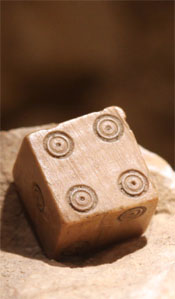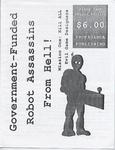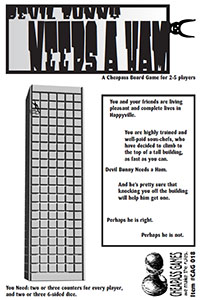Tagline: “Have you ever wondered what your dice when you’re not using them?” You’re about to find out – whether you want to or not.
A couple of days ago an interesting e-mail cropped up in my mailbox: Seth Ben-Ezra, lead designer and publisher of Dark Omen Games, was inviting me to review their new game — Dice Wars — which was freely available from their website. Well, hell, who am I to say no to those who seek me out? Besides which he was groveling (no, really, he told me he was groveling), and I just hate to see that in a grown man. So I popped over and took a look.
CONCEPT
“Have you ever wondered what your dice when you’re not using them?” You’re about to find out – whether you want to or not.
Basically once you’ve got a taste for the game’s concept the rest will quickly become obvious: Your dice are alive. They form societal units based on their die sizes and types (“a black die probably won’t get along with a sparkly pink die, for what should be obvious reasons”). There’s a fairly well-developed and semi-extensive (given the short nature of the rules) section on die-type personalities: “The four-siders are the craziest of all dice…” “The d10s are the shock troops of dice wars. Many defenses have crumbled before formations of d10s…” “d8s, as a rule, suffer from an inferiority complex…” And so forth. My favorite is the section on “Monstrosities”: “Legend speaks of other dice. Dice that have been mutated beyond recognition. Old dice whisper stories of dice with 16 sides, 30 sides, and even 100 sides.”
Every so often, though, the dice are seized by “the Rage” – capable of sending an entire dice bag into a complete frenzy of violence.
That’s when you have…. Dice Wars!
THE RULES
The game consists of a set of rules (available in HTML, MS Word, and Acrobat) and a “Battlemap” (available as a set of GIF files and a PDF).
The game itself is scenario-based – you set the dice up for combat based on pre-designed scenarios. Many of the scenarios contain victory conditions. Unfortunately, this leads us to my first set of major critiques of the game.
First, there are only two scenarios include: “All Out War” and “Saving Private Ryan”. The former being a basic combat scenario, the other being a “rescue the captive die” scenario in which some special rules are presented for that. Just some basic, and fairly obvious, variants (“capture the flag”, “battle of the monstrosities”, etc.) leap to mind with ease. This wouldn’t be such a problem except for the fact that no coherent rules are given for the creation of new scenarios.
Second, the rules state: “Additionally, regardless of the scenario, one victory condition always applies. If you lose all of the dice that you assigned to the battlefield, you lose.” Personally, as many of you know, I like to keep as much flexibility as possible. When someone lays down a “thou shalt not” like this my first response is: “Oh yeah, what about situation X?” In which situation X would be a plausible scenario in which such a victory condition would not apply. For example, the capture of an enemy die as your victory condition – kill all the enemy and you lose. Keep your options open.
Third, I downloaded the PDF versions of the rules. Each scenario is supposed to be accompanied with a diagram of how to lay your dice out on the BattleMap – unfortunately this diagram is missing.
Moving on: Each scenario gives an army size for each side, which is then created from the forces in your dice bag. For example, in a 100-sided game you’d take a selection of dice which totaled 100-sides between (five d20s; one d20 and eight d10s; etc.). You then your “general staff” (a concept which is never explained) to determine initiative in placement – whoever wins places one of their dice, then the other, and so on until all dice are placed. Depending on the scenario you may then select a “Fearless Leader”, a die which has certain positive combat effects (but also causes you to lose initiative on the next turn if it ever dies).
To begin the actual game you again roll your “general staff” (still don’t know what it is) to determine “activation initiative”. The player who wins “activates” (an arcane wargame term which means “move”) one die – the fewer sides a die has, the farther it can move on a given term. Once a piece has been activated, you should place an activation counter under it so that you don’t accidentally move it again on this turn. Activation then alternates, just like placement.
Once all your dice have moved, combat takes place between any enemy groups which have found themselves in the same space. Basically it works like this: The “attacker” (a concept which is not clearly defined, but I assume means the person moving into a square which was occupied first by the other player) pair off dice into sub-grouping called melees – in other words, he pairs up some of his dice with the dice of the other player. For example, the attacker might pair his d10 up against the defender’s d6; his d20 and d6 up against the defender’s d10.
At this point you then roll each melee (adding multiple scores together) – whoever has the higher score wins, and the other dice are removed from play. (Note: At the end of a round there may still be dice from both sides left alive in the square. You stop after a single round of combat resolution.)
It shouldn’t take more than a couple seconds for you to start seeing the problems: While there are some rules limiting exactly how the attacker can distribute the dice (the player who has fewer dice has melee groups of only one die each, and the other player cannot have three dice in a melee group until all of his groups have two dice in them), this is still hugely unfair to the defender – who, actually, should logically be able to determine what formations his or her defenders are in.
The simplest fix for this unbalance is to simply give group assignation chores to whoever has more dice. Given the rules concerning even dice distribution this makes sense – since whoever has fewer dice will never have any choices about melee groups, anyway.
Or, for a slightly more complicated fix: If the space was occupied by a single player’s dice for a whole turn before being attacked by the other side (in other words, at least some of your dice have been standing in the space by themselves without any enemy dice present), then they get to set up whatever defensive groups they want (whether that’s one big group or lots of little groups is up to them. Then the attacker defines his attack groups (if you want to make defense a lot easier, you can let the standing defender have the ability to define lop-sided combat groups, while forcing the attacker to evenly distribute his forces – in order to represent that ability for the defender to prepare defenses, while the attacker is acting while on the move). If, on the other hand, both sides moved into the space for the first time on this turn (or are continuing a combat from a previous round in which this was true) then the rules of my simple fix (side with more dice defines evenly-distributed melee groups) apply.
To wrap things up, you can also have artillery units – which are placed in special spaces around the edges of the BattleMap. To fire artillery you roll all of the dice in the artillery pool, and then count the spaces directly in front of the artillery based on the number you roll. For example, if you rolled 1, 3, and 4 (on three artillery dice) you would count out 1, 3, and 4 spaces from your artillery – a single die is removed from every one of those spaces (whether friendly or not). There’s some additional rules on how to determine which side loses a die if the space contains troops of both sides.
SUMMARY
I’m not going to lie to you: There are quite a few problems here.
First off, the overall package suffers from an unprofessional lay-out and presentation. Details are missing, there are several broken links off of the web-pages, and the language used in the rulebook often descends into a far too casual voice (replete with unamusing attempts at humor).
Second, the rules are too cluttered (for lack of a better word). At its heart Dice Wars is a very simple, Cheapass-esque, game. But the rules often use terms which are better left to the realm of Advanced Squad Leader (“activation” being a key example). The failure to honor the KISS principle, in combo with some generally unclear language (much of which has been cleaned up in my short presentation of the rules above – particularly in the area of combat resolution), makes it so that you have to decipher the game in order to enjoy it.
Third, the rules simply aren’t flexible enough. Or, to be more precise, they aren’t as flexible as they easily could be.
Fourth, the BattleMap is too damn small – it’s useful for some squad-level stuff, but you just don’t have enough maneuverability. I’d suggest using a chessboard which is oversized enough to fit multiple dice into each square. It’ll be more fun and you won’t have to cut-and-paste.
Finally, and perhaps most damning, the rules don’t deliver on some of the neat concepts discussed in the promo material at the beginning of the game. I’d have especially liked to have seen more detailed rules on the Monstrosities, and for the “powers” of different types of dice (gems, solids, etc.).
But, at the end of the day: Should you check this one out? Well, if you were paying any significant amount of money (even at, say, a Cheapass level) for the package I’d say no. But it is a freebie. With some minor modifications and decipherment (most of which I’ve implied or done here in this review) the game becomes the simple, quick, fun playing experience I think it’s ultimately meant to be. In particular I’d highly recommend it for quick play while you’re waiting around for that perpetually late member of your gaming group to show up – you’ve already got the dice just sitting there, the rules are easy to remember, and the board is easy to improvise.
Style: 3
Substance: 2
Author: Seth and Crystal Ben-Ezra
Company/Publisher: Dark Omen Games
Cost: Free!
Page Count: n/a
ISBN: n/a
Originally Posted: 2000/03/12
For an explanation of where these reviews came from and why you can no longer find them at RPGNet, click here.
 Common misconception: It’s not accurate to say “roll the dice” when you’re only rolling a single die. It would also be inappropriate to say that you’re rolling a single dice.
Common misconception: It’s not accurate to say “roll the dice” when you’re only rolling a single die. It would also be inappropriate to say that you’re rolling a single dice.
 Government-Funded Robot Assassins from Hell – Mission One: Kill All Evil Game Designers (henceforth, for obvious reasons, referred to merely as Government-Funded Robot Assassins) is a card game dating back to 1995.
Government-Funded Robot Assassins from Hell – Mission One: Kill All Evil Game Designers (henceforth, for obvious reasons, referred to merely as Government-Funded Robot Assassins) is a card game dating back to 1995.












